heater VOLKSWAGEN GOLF PLUS 2006 Owners Manual
[x] Cancel search | Manufacturer: VOLKSWAGEN, Model Year: 2006, Model line: GOLF PLUS, Model: VOLKSWAGEN GOLF PLUS 2006Pages: 541, PDF Size: 98.86 MB
Page 241 of 541
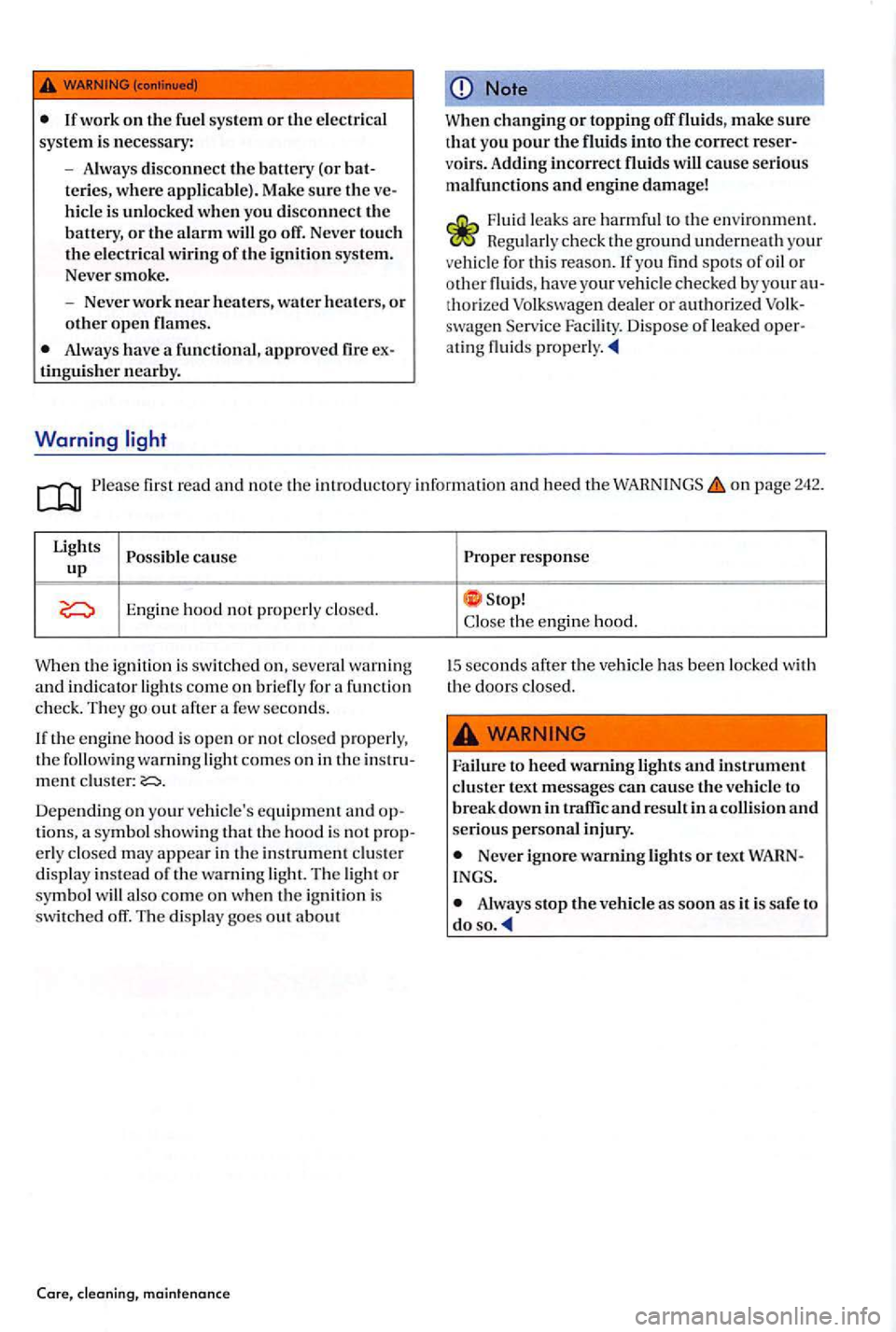
Always disconnect the batt ery (or teries, where appli cable). Make sure the hicle is unlocked when you disconnect the battery, or th e alarm w ill go off. Never touch the electrica l w irin g of the ign ition sys te m .
Neve r smoke.
Never work near heaters, water heaters, or other open flames.
Always have a functional, approved fire tinguisher nearby.
Warning
Note
W hen c
hangin g or topping off fluid s, make sure that you pour the fluids into the correct voirs. Addin g incorrect fluids will cause serious
malfunc tions and engine damage!
Fluid leaks are harmfu l to the environm ent.
thori zed Volkswagen dealer or authori zed swagen Serv ice Faci lity. Dispose of le aked at ing fluid s
first read and note the in tr o du ctory informat io n and heed th e on p age 242.
Lights ca use up
Engine hood not proper ly closed.
When the ignition is sw
itched on, several warning
a nd in dicator light s co me on bri efly fo r a functio n
c h eck. They go out after a few seconds.
If th e engi ne hood is open or not clos
ed properly,
the following warning light comes on in the ment cluster:
tions , a sy mbol showing th at the hood is not erly clo sed may appea r in th e in stru ment clu ste r
di splay instead of the warnin g light . Th e light or sy mbo l will als o com e o n whe n th e ig nition is swit ched off. T he di splay goe s out about
Core,
response
Close the eng ine hood.
I S seconds
after the vehicle has been locked with
the doors closed.
Failure to heed warning lights and instrument cluster text messages can cause the vehicle to
break down in traffic and res ult in a co llision and se riou s personal injury.
Never ignore warning lights or text
Always stop the vehicle as soo n as it is safe to do
Page 249 of 541
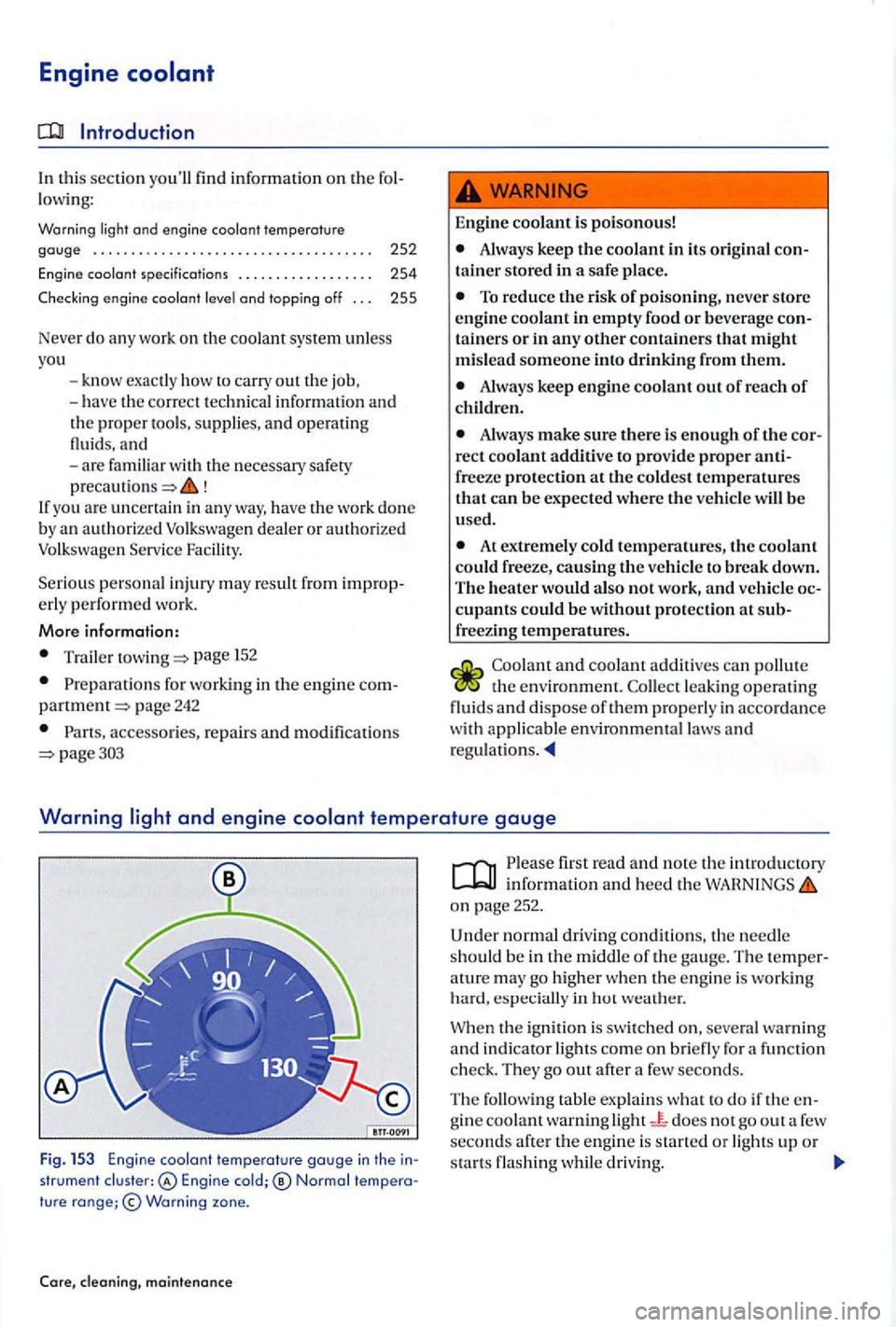
Engine coo la nt
Introduction
In thi s section you'll find informat ion on the following:
Warning
engine coolant and topping off . . . 255
Never do a ny wor k on the coo lant system unless
you
-know exactly ho w to carry out the job,
-have the correct tec hnical informa tion and
th e proper to ols, supplie s, and operating
fluid s, a nd
-are familiar with the necessary safet y
pr eca utions
Traile r page 152
fo r work ing in the e ngine compartment page 242
Part s, acce ssories , re pair s and modification s
Engin e coo lant is poisonous!
Always keep the coolant in its origi nal con
t ainer stored in a safe place .
To reduce the risk of poisoning, never store engine coolant in empty food or beverag e containers or in any other containers that might mislead someone into drinking from them.
Always keep engine coolant out of reach of c hildr en.
Alway s make sure there is enough of tJ1e cor
re ct coo lant additive to provid e proper anti
fr eeze protection at the cold es t temperatures that can be expected where the vehicle will be used .
At extremely cold temperatures, the coolant could freeze, causing the vehicle to break down.
The heater would also not work, and vehicle oc
cupants could be without protection at subfreezing temperatures.
leaking operat ing
fluids and dispose of t h e m properly in acco rdance
w ith applicable environmental laws and regulat ion s .
Warning light and engine coolant temperature gauge
Fig . 153 E ngine coolant temperature gauge in the instr umen t Engi ne cold;® Normal temperature range;© Warn ing zone.
Core, maintenance
first read and note th e introduct ory information and heed th e on page 252.
normal driving conditi ons, th e needle
s h o uld be in the middl e of th e ga uge. The temper
ature may go high er w hen th e e ngine is w orking
h ard, espec iall y in hut
When the igni tion is sw itch ed on , seve ra l warnin g and indicator light s co me o n bri efly fo r a function
c h ec k. The y go our after a few seconds.
Th e fo
llow ing table explains w ha t t o do if th e en
gine coolant warn ing does no t go out a few secon ds after the engine is s tart ed or light s up or
s tart s fla sh ing while driving.
Page 251 of 541
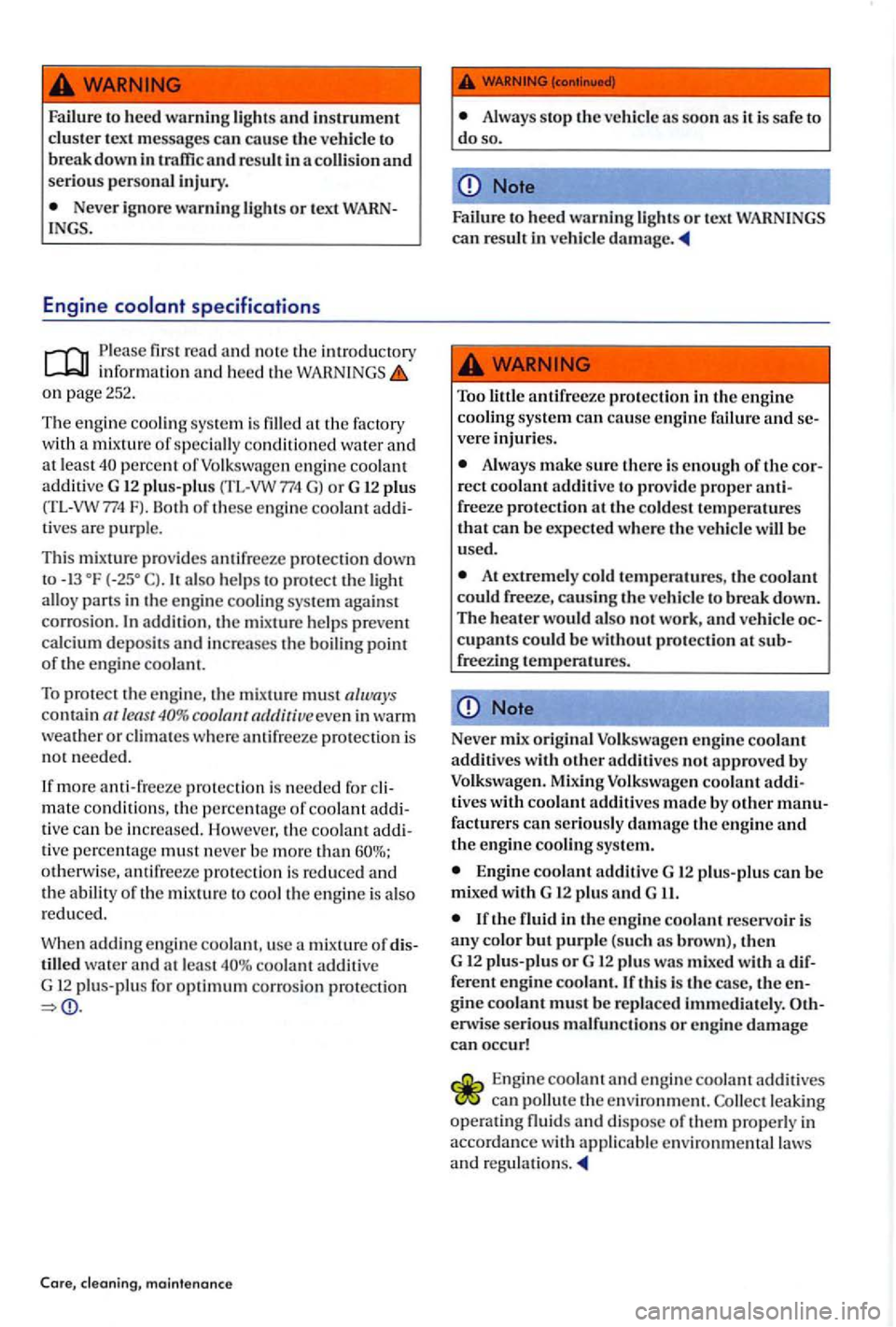
Failure to heed warnin g light s and instrument cluster text message s can cause the ve hicl e to break down in traffic and result in a and seriou s personal injury .
Never ignore warning light s or text I NGS.
Engine coolant specifications
introdu ctory information and heed th e on pag e 252.
The engi ne c ooling sys tem is fille d
p erce nt of Volk s wa gen engi ne coo lant additi ve G 12 plu s-plu s (TL-VW 774 G) o r G 12 plus (TL -VW F). Both of these engin e coola nt ti ve s are purple.
This mixtur e pro vides antif r eeze pro te ction down
to -13 a ls o he lps to pro tec t th e light
allo y pan s in th e eng in e coolin g sys te m against
corro sio n. In addit ion, the mi xture help s preve nt
c alcium dep os its and in creases the bo ilin g point of the e ng in e coola nt.
T o
protec t th e e ng in e, the mi xture must a lway s co nt ain nt le a st
mate conditions , th e perc entage of coola nt ti ve can be in cre ased. Howe ver, the coo la nt ti ve pe rc e n ta ge mu st never be m ore than oth erw ise , ant ifreeze prot ection is reduce d a nd
th e ability of the mi xture to coo l th e e ngine is als o
r educed.
Whe n addin g e ngine coolant, use a mixture of till ed water and at l ea st c o o la nt addit ive G 12 plu s- plu s for optimum co rro sion protection
Core, maintenanc e
Always stop the vehicl e as soon as it is saf e to do so.
Note
Failure to heed warning lights o r text can re s ult in veh icle damage.
Too little antifreeze protection in the en gin e coolin g syste m can cause eng in e failure and vere injuri es.
be used.
At extremely cold temperatures, the coolant could freeze, cau sin g the v ehicl e to brea k down. The heater would als o no t work, and ve hicl e cupants could be without protection at free zing temperatures.
Note
N eve r mix original Volkswagen engine coo lant additives with other additi ve s no t approved by
Volkswagen. Mixing Volkswage n coo la nt
facturers can serio usly damage th e engine and th e engi ne coolin g sys te m .
Eng in e coolant additive G 12 plus-plus can b e
m ixed with G 12 plus and G
If the fluid in th e e ngine coo lant res ervoir is any color but purple (s u ch
this is th e case, the gin e coolant mus t b e r epla ced immedi ate ly . envi se serious m alfun ction s or engine damage can occ ur!
E ng in e coolan t a nd engine c oo lant additi ves can pollute th e environm ent. le akin g opera ting a nd disp ose of th em in
acco rdance with appli cable e nvir o nm ent al la ws
a nd
Page 293 of 541
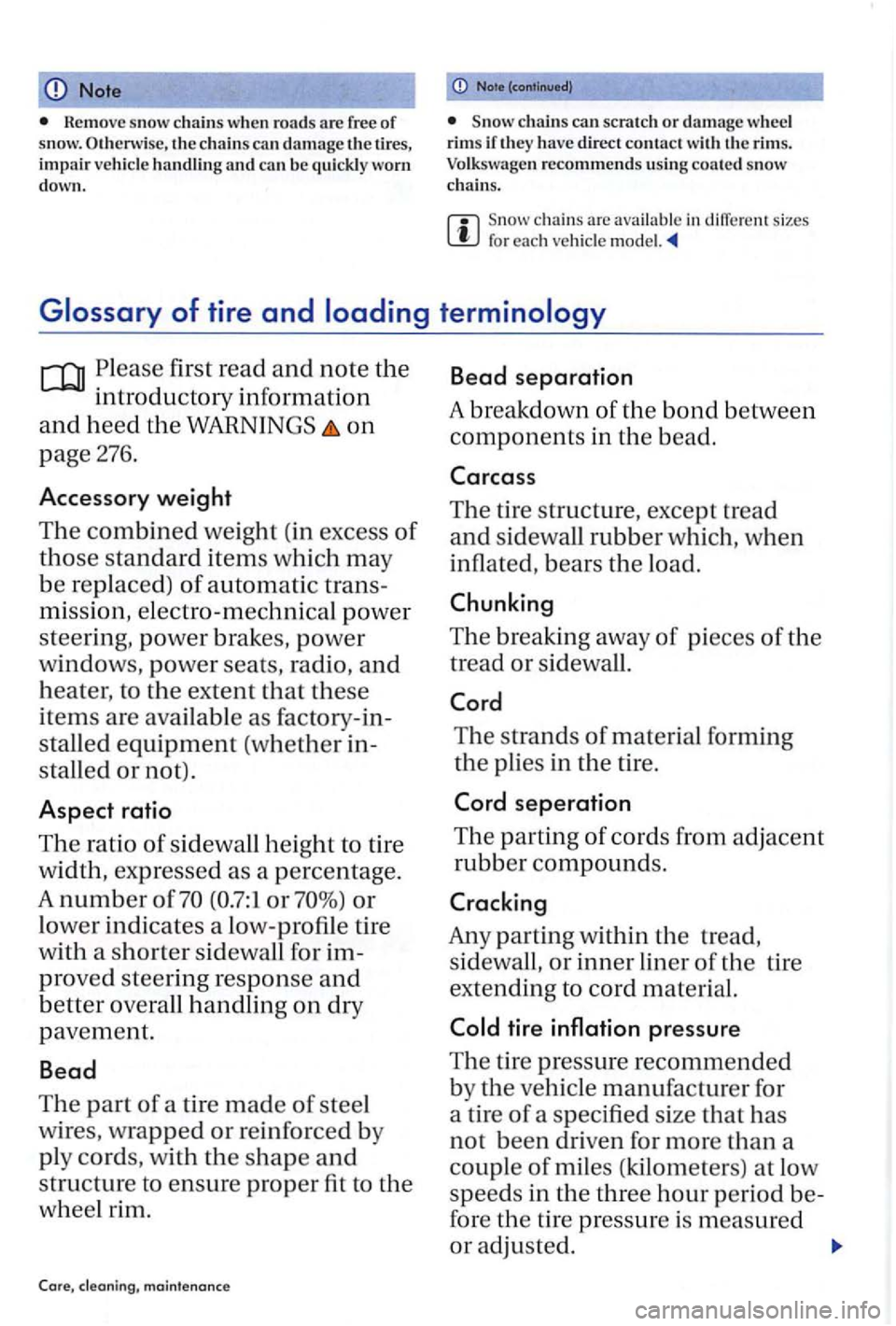
Note
Remove sno w c hain s w hen road s are free or snow. the chains ca n damage tires, impair vehicle handling and ca n be qui ck ly worn
down.
-------chain s they h ave direct contact w ith th e rims. Volk swage n recommend s usin g coa te d sn ow
chains .
c hain s are available in different sizes
Please first read and note the
introductory information
and heed the WARNINGS on
page 276.
Accessory weight
The combine d weight (in excess of
those standa rd items which may
be re placed) of automatic tra n s
mission, electro-mechnical power
stee ring, power brakes, power
windows, power seats, radio, and
heater, to th e extent that these
items are availabl e as factory-in
stall ed equipme n t (w hether in
s tall ed or not).
Aspect ratio
The ratio of sidewall heig h t to tir e
w
idth, expressed as a p ercentage.
A number o r or
lower indicates a low-profile tire
with a shorter sidewall for im
proved steering response and
better overall handling on dry
pavem ent.
Bead
The part of a tire made of steel
wires, wrapped or reinforced b y
ply cords, with the shape and
structure to en sure proper fit to the
w h
eel rim.
maintenance
Bead separation
A breakdown of the bond between
components in the bead.
The tire structure, excep t tread
and s id ewall rubber which, when
infl ate d, bears the lo ad.
The breakjng away of pieces of the
tread or sidewall.
The strands of materia l forming
the plie s in the tir e.
An y parting within the tread,
s id
ewall, or inne r lin er of the tire
ex te
nding to cord material.
at low
speeds in the three hour p e riod be
fore
the tire pressure is measured
o r a
djuste d.
Page 352 of 541
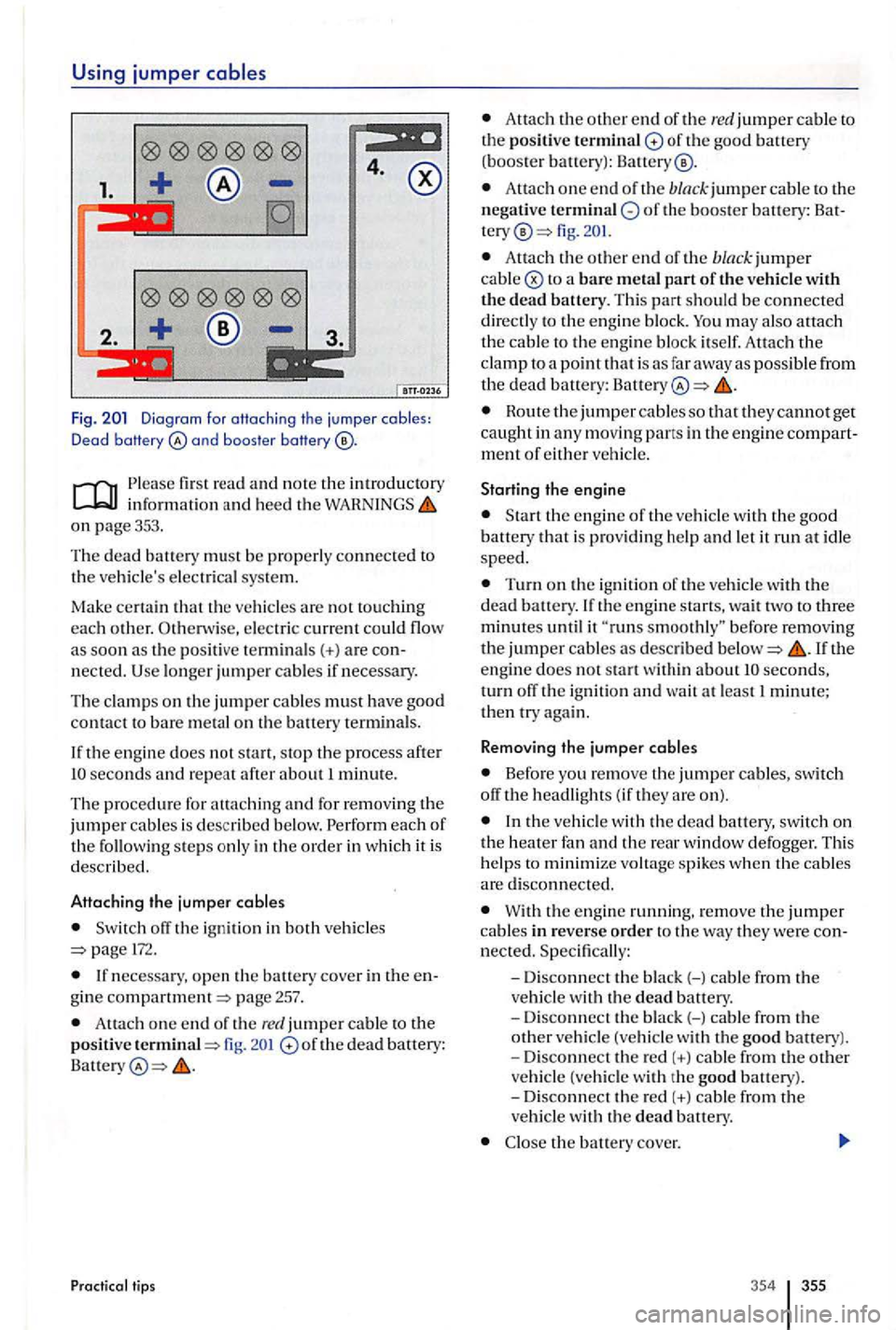
Using jumper
4.
1.
2.
Fig. and boos te r baHery
informat ion and heed the on page 353.
Th e
dead battery must be properly connected to
th e ve hicle's electri cal sys tem.
Ma
ke certain
pos iti ve termin als(+) a re
the engine does not start, stop the process after seconds and repeat after about 1 minute.
Th e procedu re for attach ing
and for removing the jumper cables is desc ribed below.
off the ign ition in both vehicle s 172.
gine compartment=> page 257.
Attach one end o f th e red jumper cable to the positive termina l=> fig. of th e dead battery:
Pr actical tips
Atta ch the o ther end of the re d jumper cable to th e positive terminal of the good battery (booster battery):
Attach one e nd of the black jumper cable to th e
n egative of the booste r battery : fig.
Attac h the oth er e nd of the bla ck jumper cable
may also attach the cable to the e ng in e bl oc k itself. Attach the clamp to a poi nt that is as far away as possible from the dead battery: Battery
Route the jumper cable s so that they cannot get caught in a ny moving pans in th e engine ment of either vehicle.
Starting the engine
is prov idi ng h elp and let it run at i dle speed.
Turn on the ign ition of the ve hicle with the dead battery.
seconds, turn off th e ignition and wa it at least 1 minute; then try again.
Remo ving the jumper cables
Before yo u remove the jumper cables , switch
off the headligh ts ( if they are on).
the ve hicl e w ith the dead battery, switch on the heater fan and the rear window defogger. This
h elp s to minimize voltag e spikes when the cables are disconne cted.
With the engin e running. remove the jumper cable s in reverse order to the way they we re
the bauery cove r.
354 355